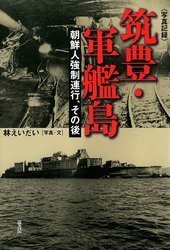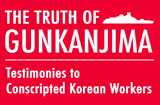
“<Photographic Record> Chikuho / Gunkanjima – Conscription of Korean Workers and After”①
The wrapper of this book says “The history of misery of the Koreans who became victims of the war and the coal industry. 380 pictures collected over half a century and reportage reveal the truth of conscription”. The author is a nonfiction writer, Mr. Eidai Hayashi. Mr. Hayashi states about Hashima, “Shouldn’t we seriously think how many miners had to shed their blood here? We must not forget that the history of Hashima was founded on the sacrifice of Japanese, Koreans and Chinese. Hashima is not an island for tourism, but an island where we should mourn for the victims of mining, especially for Korean and Chinese workers.” Please take note of the reactions of the former Hashima Islanders to his reportage in listening to their testimonies.
CLAIM
"Photographic Record: Chikuho/Gunkanjima
- Chosenjin Kyosei Renko, Sonogo"
Photo/written by Eidai Hayashi
Published by Genshobo in 2010
Co-workers died in an accident. As we cremated their bodies, Labor Division's personnel ordered us to scoop their ashes and throw in an abandoned shaft.“<Photographic Record> Chikuho / Gunkanjima
– Conscription of Korean Workers and After” P.158
Testified by an anonymous former worker who lives in Nagasaki
War veterans patrolled to prevent escape during the war.“<Photographic Record> Chikuho / Gunkanjima
– Conscription of Korean Workers and After” P.158
Witness unknown, described by Eidai Hayashi
The number of workers in Hashima Mine increased along with its expansion. It reached 5,300 at its peak in 1945, with people almost flowing out of the island.“<Photographic Record> Chikuho / Gunkanjima
– Conscription of Korean Workers and After” P.158
Witness unknown, described by Eidai Hayashi
We grew rice and vegetables on the rooftop during the war with food shortage.“<Photographic Record> Chikuho / Gunkanjima
– Conscription of Korean Workers and After” P.160
Witness unknown, described by Eidai Hayashi
The movie theater was our only amusement. It was called Kyowa Kaikan during the war.“<Photographic Record> Chikuho / Gunkanjima
– Conscription of Korean Workers and After” P.160
Witness unknown, described by Eidai Hayashi
183 were from Hebei, 20 from Shandong, 1 from Yunnan, 204 in total. They came by Asagaomaru, the company boat, escorted by armed Omura troops.“<Photographic Record> Chikuho / Gunkanjima
– Conscription of Korean Workers and After” P.162
Witness unknown, described by Eidai Hayashi
Getting abused by a Japanese instructor, 2 Chinese workers counterattacked him with their shovels and injured him badly. Only the Chinese men were condemned, taken to the Labor Division's office and got beaten, so it triggered a riot. All workers refused to work and went on a hunger strike.The mine requested Nagasaki Prefecture to send in the army. Omura troops came and subdued the riot, and the mine sent the 2 Chinese men to Hokkaido. However, a furious battle went on between the troops and workers.“<Photographic Record> Chikuho / Gunkanjima
– Conscription of Korean Workers and After” P.162
Testified by Kang Si Do, a transferred worker to Karafuto
It was easy to steal a stick of dynamite out of the bunches for mining. We could easily blast it in the mine filled with methane.“<Photographic Record> Chikuho / Gunkanjima
– Conscription of Korean Workers and After” P.162
Testified by Kang Si Do, a transferred worker to Karafuto
They treated Chinese people really badly. When Koreans talked to them, armed Labor Division's personnel stopped them, sometimes by punishing both parties.“<Photographic Record> Chikuho / Gunkanjima
– Conscription of Korean Workers and After” P.162
Witness unknown, described by Eidai Hayashi
As the air raids by the U.S. increased, Hashima's power plant was bombed and the power inside the mine was cut. Pumps stopped and the mine was flooded, but Chinese workers were accused of cutting the power and investigated by the military police.“<Photographic Record> Chikuho / Gunkanjima
– Conscription of Korean Workers and After” P.162
Witness unknown, described by Eidai Hayashi
It's described that the company hired prostitutes, had them open brothels everywhere, while recommending gambling.“<Photographic Record> Chikuho / Gunkanjima
– Conscription of Korean Workers and After” P.164
Sited from Japan Labor Management Annual Report:
"Mitsubishi Hashima's Labor Situation"
he statement of Kinsaku Sakurai from Hiroshima was reported in Nagasaki Daily News in 1941. "Unable to take anymore maltreatment in Takashima, some swam away from the island by tying sake barrels on their bodies, dodging their ways through the lookout.It's been 18 years since I moved to Hashima, but at first, it was also like jail cells, and bloody incidents happened every day.“<Photographic Record> Chikuho / Gunkanjima
– Conscription of Korean Workers and After” P.164
Kinsaku Sakurai's comment in the report of Nagasaki Daily News
Police posted many officers in Nomo Peninsula for surveillance. They arrested runaways as criminals.“<Photographic Record> Chikuho / Gunkanjima
– Conscription of Korean Workers and After” P.164
Witness unknown, described by Eidai Hayashi
Drinking water and the water for our shared bath was brought by the mine's water boat every day from Doinokubi on the opposite shore. My husband carried water from the tank on the ground level up to 7th floor, climbing steep stairs. To fill up the vase in our kitchen, he had to go up and down for 5 to 6 times, which was extremely tough.My husband called these, "stairs from hell". There still are the vases in the abandoned apartment.
– Conscription of Korean Workers and After” P.165
Testified by Kang's wife, Kang Si Jum
In the lowest floors of apartment buildings, laundry didn't get dried, so it was hard for the wives who lived there. The spray from waves was so significant that we couldn't hang laundry anywhere but the rooftop.“<Photographic Record> Chikuho / Gunkanjima
– Conscription of Korean Workers and After” P.165
Testified by Kang's wife, Kang Si Jum
When they tried to take home the coal they mined, it was confiscated by managers at the gate inspection. We bought home-use firewood from Takahama. Sometimes, wax tree branches were mixed in it, and if it touched my skin, my entire body got swollen in red and my vision got blurred.“<Photographic Record> Chikuho / Gunkanjima
– Conscription of Korean Workers and After” P.165
Testified by Kang's wife, Kang Si Jum
Hashima Mine was dug very deep under the sea bottom, so it was extremely hot and miners sweated a lot. They brought 2 water bottles but they drunk it quickly. Sometimes, Japanese miners took their bottles and drunk it. Protested, they just told them that Koreans should drink water in the shafts.“<Photographic Record> Chikuho / Gunkanjima
– Conscription of Korean Workers and After” P.166
Testified by Kang's wife, Kang Si Jum
Groundwater flew into the mine, but there were no toilets so they defecated in the water. Infectious diseases spread fast because they drunk unsanitary water from there.“<Photographic Record> Chikuho / Gunkanjima
– Conscription of Korean Workers and After” P.166
Testified by Kang's wife, Kang Si Jum
Especially when Koreans caught a cold, it wasn't admitted as sickness and they were thoroughly hit by Labor Division's personnel. They tied someone on the electric pole in the waiting area and made other miners hit him.“<Photographic Record> Chikuho / Gunkanjima
– Conscription of Korean Workers and After” P.166
Testified by Kang's wife, Kang Si Jum
Typhoon was like Hashima's specialty. When the sea was rough, waves splashed up to the front door of our apartment on the 7th floor. Inside got flooded, so we had to quickly get the tatami mats up into the closet.“<Photographic Record> Chikuho / Gunkanjima
– Conscription of Korean Workers and After” P.167
Testified by Kang's wife, Kang Si Jum
Half of distributed food for Korean dorms was snatched by Labor Division's personnel. On top of severe working conditions, the food for Korean workers was stolen.“<Photographic Record> Chikuho / Gunkanjima
– Conscription of Korean Workers and After” P.169
Testified by Kang's wife, Kang Si Jum
In 60cm bedrocks, we had to dig with short pickaxes in lying position. The cord of my cap lamp wrapped around myneck and legs, while my head was bumping the ceiling bedrock. My lower body went numb only in 10 minutes.“<Photographic Record> Chikuho / Gunkanjima
– Conscription of Korean Workers and After” P.185
Testified by Ryu Hui Geung, an escaped Korean
I've never heard that anyone succeeded to escape from the island. They tried only to be caught, tortured by Labor Division's personnel, and thrown to the sea.“<Photographic Record> Chikuho / Gunkanjima
– Conscription of Korean Workers and After” P.185
Testified by Ryu Hui Geung, an escaped Korean
Lee pointed at a strange man fishing one night. Then we realized men in straw hats were fishing at interval of 50m. As we closely watched, no one changed the bait on their fishing poles.As we went near them and saw some faces, they were Labor Division's personnel, and they looked away. We realized that they watched for runaways 24/7.“<Photographic Record> Chikuho / Gunkanjima
– Conscription of Korean Workers and After” P.185
Testified by Ryu Hui Geung, an escaped Korean
The measure for escaping was thorough. A motor boat ran around the island, while search lights were lit on the breakwater at night without air raids.“<Photographic Record> Chikuho / Gunkanjima
– Conscription of Korean Workers and After” P.186
Testified by Ryu Hui Geung, an escaped Korean
DISPROOF
"Photographic Record: Chikuho/Gunkanjima
- Chosenjin Kyosei Renko, Sonogo"
Verification 1) About ashes
Verification 2) About war veterans
Verification 3) About population in 1945
Verification 4) About growing plants on the rooftop
Verification 5) About the name of the movie theater
Verification 6) About Asagaomaru
Verification 7) About subduing a riot
Verification 8) About handling dynamite
Verification 9) About carrying weapons
Verification 10) About power failure
Verification 11) About brothels and gambling
Verification 12) The statement of Kinsaku Sakurai
Verification 13) About arrest of runaways
Verification 14) About carrying water
Verification 15) About the place for drying laundry
Verification 16) About the fuel for homes
Verification 17) About drinking water in the mine
Verification 18) About water in the mine
Verification 19) About the electric pole in the waiting area
Verification 20) About spray from waves
Verification 21) About exploitation by Labor Division's personnel
Verification 22) About digging in lying position
Verification 23) About dead bodies thrown to the sea
Verification 24) About surveillance by Labor Division's personnel
Verification 25) About a motor boat
証言:真実の歴史を追求する端島島民の会
Testimony by Sakae Matsumoto,
Honorary Chairman of the Association of Hashima Residents Pursuing Truth in History
Source: National Diet Library
Mr. Eidai Hayashi explained in the “postscript” of this book that his father, who was a Shinto priest, was tortured by the Special Higher Police for helping a Korean escapee; and died from the ordeal in 1943 when Eidai Hayashi was 11 years old. Later, when he tracked down and reproached the 90-year-old former Special Higher Police officer who tortured his father, the officer apologized and explained that those who helped Korean escapees were considered anti-national in WWII. Increasing coal production was the number one priority at a time when “A lump of coal is a bullet” was the slogan, and that he had to investigate the background. Mr. Hayashi said, “I’m proud of my father for what he did although he was treated as anti-national and unpatriotic then. As the son of the anti-national and unpatriotic, I came to realize that my mission is to mark in the history the legacy of life that my parents left to me.”


